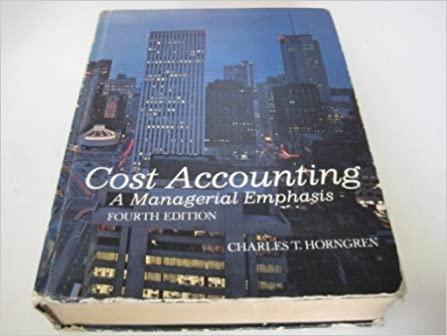Divisional Contribution, Performance, and Segment Margins The president of the Midwestern Railroad wants to obtain an overview
Question:
Divisional Contribution, Performance, and Segment Margins ‘The president of the Midwestern Railroad wants to obtain an overview of his operations, particularly with respect to comparing freight and passenger business. He has heard about some new “contribution” approaches to cost allocations that emphasize cost behavior patterns and so-called contribution margins, contribution controllable by division managers, and contribution by segments. Pertinent data for the year ended December 31, 19_2, follow:
Total revenue was $100 million, of which $90 million was freight traffic and $10 million was passenger traffic. Half the latter was generated by Division 1; 40 percent by Division 2; and 10 percent by Division 3.
Total variable costs were $56 million, of which $44 million was freight traffic. Of the $12 million allocable to passenger traffic, $4.4, $3.7, and $3.9 million could be allocated to Divisions 1, 2, and 3, respectively.
Total separable discretionary fixed costs were $10 million, of which $9.5 million applied to freight traffic. Of the remainder, $100,000 could not be allocated to specific divisions, although it was clearly traceable to passenger traffic in general. Divisions 1, 2, and 3 should be allocated $300,000, $70,000, and $30,000, respectively.
Total separable committed costs were $30 million, of which 90 percent was allocable to freight traffic. Of the 10 percent traceable to passenger traffic, Divisions 1, 2, and 3 should be allocated $1,800,000, $420,000, and $180,000, respectively; the balance was unallocable to a specific division.
The joint fixed costs not clearly allocable to any part of the company amounted to $1,000,000.
1. The president asks you to prepare statements, dividing the data for the company as a whole between the freight and passenger traffic and then subdividing the passenger traffic into three divisions.
2. Some competing railroads actively promote a series of one-day sightseeing tours on summer weekends. Most often, these tours are timed so that the cars with the tourists are hitched on with regularly scheduled passenger trains.
What costs are relevant for making decisions to run such tours? Other railroads, facing the same general cost picture, refuse to conduct such sightseeing tours. Why?
3. For purposes of this analysis, even though the numbers may be unrealistic, suppose that Division No. 2’s figures represented a specific run for a train instead of a division. Suppose further that the railroad has petitioned government authorities for permission to drop. No. 2. What would be the effect on overall company net income for 19_3, assuming that the figures are accurate and that 19_3 operations are in all other respects a duplication of 19_2 operations? ;
Step by Step Answer:






